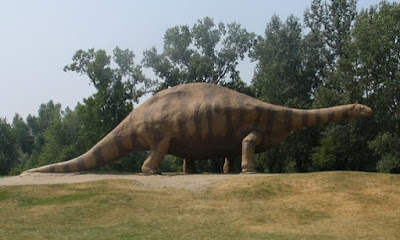If in Job 40:15 behemoth was simply noted and God moved on, it is easy to assume that Bible readers and scholars would have imply written it off as some animal of which Job was aware. The confusion results from the further descriptions of behemoth in the rest of the chapter.
There are several reasons why scholars and us reg'lar folk may wonder what that beasie is, what with having immense power and a tail like a cedar. The first is that the Bible does use real animals and names in symbolic passages, such as Rahab (Joshua 6:25, Isaiah 51:9) and Leviathan (Job 41:1, Isaiah 27:1). Since the behemoth was unknown, maybe this was something strictly symbolic. But that doesn't fit with the text because God was not referring to mythical or symbolic creatures.
A second reason people are baffled is because this animal is unknown and apparently no biblical references exist outside the book of Job. Biblical creationists believe that the text supports the idea that this was a dinosaur (Job 40:16-18) that hadn't seen fit to become extinct yet. Through the years, people did not have a frame of reference until fossils of sauropods were unearthed and reconstructed.
But what is the biggest problem is that professing Christians and believing Jews give the magisterial position of atheistic interpretations of science philosophies. These owlhoots are denying the authority and perspicuity of Scripture.
 |
| Image cropped from Pixabay / Ladycoffee |
A second reason people are baffled is because this animal is unknown and apparently no biblical references exist outside the book of Job. Biblical creationists believe that the text supports the idea that this was a dinosaur (Job 40:16-18) that hadn't seen fit to become extinct yet. Through the years, people did not have a frame of reference until fossils of sauropods were unearthed and reconstructed.
But what is the biggest problem is that professing Christians and believing Jews give the magisterial position of atheistic interpretations of science philosophies. These owlhoots are denying the authority and perspicuity of Scripture.
In Job 40:15, God tells Job to “Behold, Behemoth,” calling him to take notice of this creature. The Hebrew word bĕhēmôt (בְּהֵמוֹת) is the plural form of bĕhēmâ (בְּהֵמָה), a generic word used to describe the domesticated “beasts/livestock” of the earth that God created on day six of creation week (Genesis 1:24) and that went onto the ark and then came out of the ark (Genesis 6:20, 9:10). In verse 15, the plural form bĕhēmôt refers to a single creature but uses the plural of majesty. Scholars recognise that this implies a “super beast” or “the beast par excellence.” What is clear, from v.15, is that Behemoth and Job have one thing in common: they are both creatures of God. The words “which I made as I made you” work “against the view that “behemoth” is a mythical creature.” A real earthly creature is clearly in view, as Konkel rightly recognizes in his commentary on Job:To read the article in its entirety, click on "Scholars and the Mystery of Behemoth".
